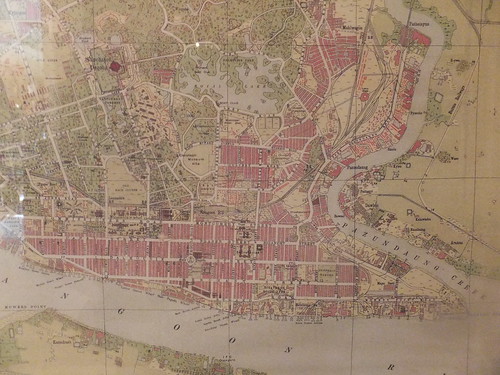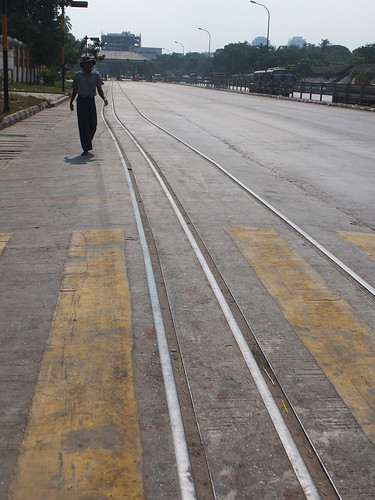Steam trams were introduced in Rangoon (as the British called Yangon) towards the end of the 19th century, without conspicuous success. The system was electrified in the early 20th century and, by the mid 1930s, was carrying 40 million passengers a year.

Shwedagon tram terminus in the 20th century (Photo: Tram Views of Asia).
Bombing of power stations by both the British and the Japanese during World War II led to power shortages which sealed the fate of the Rangoon Electric Tramway, although post-war wrangling over shareholder compensation meant that the company was not finally liquidated until 1961. There's a brief article on this period here.
The Building of Rangoon's Docks
The British developed extensive docks on the north shore of the Yangon River with extensive rail access from the British-built metre gauge railway system. Like Liverpool's docks, Rangoon's docks were enclosed and, just outside the enclosing walls of the docks, there is a dock access road which runs parallel to the important Strand Road built on the landward side. The dock access road was provided with a railway line with sidings into the docks at various points. At the western end of the docks, this line branched inland to reach interchange sidings with the main railway system at Kyee Myin Daing. At the eastern end of the docks, a second branch went inland to meet the main railway system at Pazundaung. Just north of Pazundaung, a large marshalling yard and motive power depot was built at Mahlwagon. There's a description of a visit to Mahlwagon area here.
The Rangoon Guide Map of 1930 (published under the direction of Brigadier R. H. Thomas D.S.O., Surveyor General of India) gives a good idea of the extent of the docks at that date and the elaborate network of railway sidings built to serve the docks.
 The central area of docks in 1930.
The central area of docks in 1930.Click here for a larger view
Recent Developments in Yangon's Docks
Like Liverpool, Yangon's dock area has seen massive changes with the introduction of Containerisation, including the construction of a completely new deep-water port at Thilawa, 16 miles from Yangon (see website here). In 2014, exploring Strand Road, I was surprised to find that the railway line along the dock access road, inset in concrete, was now dual-gauge (metre/standard gauge).

Looking west along the Dock Access Road, Strand Road, Yangon in 2014, showing dual gauge (metre/standard gauge) track.
This discovery is described in the post here. I found the railway goods depot still in use at Botataung (on the landward side of the line) and, later, I confirmed that there's a second depot still operating at War Dan (on the river side of the line). Although I was now certain that metre gauge trains must still run along this dock line to service these depots, it was not until Tuesday 5th May 2015 that I actually saw an unidentified Bo-Bo-Bo diesel-electric slowly make its way westbound along the dock line with a short train of bogie vans as I took afternoon tea in the Cafe at the Strand Hotel at about half past five. The following morning, I had a greater surprise for, at twenty past seven whilst taking breakfast in the Cafe at the Strand Hotel, red-liveried railcar RBE 30.02 paused briefly opposite on its way east on the dock line.
Plans for Yangon's Electric Railway Revealed
Before I had an opportunity to investigate the standard gauge trackwork and whether there was now a passenger service along Strand Road, my railway friend in Myanmar informed me that Yangon was to open a new Electric railway and I found limited information on the internet.
A report on the MITV site dated 25th August 2015 (see [reference 1] below) stated that carriages of electric train (tram rail) which would be used for the first time in public transport of Myanmar had arrived at Thilawa Port, and would commence operation in October 2015. The project, led by Myanma Railways, was intended to provide better services and facilities for train commuters. U Ohn Kyi, Assistant General Manager, Myanma Railways (Lower Myanmar) claimed that 18 freight, 379 passenger and 25 Circular trains were currently operated but the electric train project would construct three new electrified lines, ultimately leading to an electric Circular train in addition to the current Circular Line services which transport around 100,000 people a day. U Kway Lwin, Assistant Engineer, Myanmar Railway (Urban), added that the new lines would be standard gauge.

One of the 'new' trams, numbered 3005B in 'salmon pink' livery (Photo: MITV).
The announcement was starting to make sense to me. I already knew that Myanma Railways 'RBE' single-unit diesel railcars were actually supplied second-hand from Japan (see report Diesel Railcars in Burma). In 2013, I first saw other second-hand diesel multiple units from Japan starting to appear and, on my most recent visit in 2016, I found that 5-car Diesel Multiple Units are now common around Yangon. This initiative is part of a comprehensive plan put forward by the Japan International Co-operation Agency (JICA), outlined in my post here. If diesel railcars and diesel multiple units can be given extended usefulness in this way, why not also re-cycle second-hand Japanese standard-gauge trams to Myanmar?
I found a couple more pictures from MITV showing a 3-section tram, apparently ready for service and also a piece by 'ElevenMyanmar' reporting a deal between Myanmar Government and the "Japanese West Corporation" signed 27th July 2015 which would start operating a service the same year along the Yangon Waterfront. The Ministry of Rail Transportation said the service would open from Pansodan to Htawlikwae in Ahlone Township in October and from Pansodan to Lansdown in December. The Japanese partner would provide the specialist equipment for overhead power distribution and the Yangon Electricity Corporation would provide the 5 megawatts power required. The electric power poles would be erected 50 metres apart. Two 3-section sets and one 1-car set would be prepared and would provide speeds between 19 and 25 miles per hour. I'm not sure about the "Japanese West Corporation" but this may refer to the public company JR-West which provides transport in Western Japan.

A '3-section' tram numbered TCE3001 in its rather fetching Myanma Railways livery of two-tone blue with grey undergear (Photo: MITV).

Detail of the pantographs on TCE3001 (Photo: MITV).
My railway friend confirmed my understanding, informing me that the vehicles were type 1650 trams, originally used in Osaka, Japan and that public operations would commence on 11th January 2016.
On 22nd December 2015, Myanmar Business Today (see [reference 2] below) confirmed a delay in starting the service giving a new start date of second week of January 2016, according to U Kyaw Soe Lwin, Deputy General Manager of Myanma Railways (MR). U Htun Aung Thin, General Manager of Myanma Railway (Lower Myanmar) commented that the electric train would be fully air conditioned and have three carriages. It would run ten times per day and tickets would cost 100 Kyat each (about 10 cents U.S.). U Tun Aung Thin said the electric trains were equipped with a capacitor bank, to prevent the train from stopping suddenly in the event of an electricity cut. I'm not sure that I understand this last remark unless it refers to Ultra-capacitors retro-fitted to 40 year old rolling stock, which seems unlikely.
On 11th January 2016, MITV reported an opening ceremony the previous day (see [reference 3] below) and Myanmar Times gave a very upbeat assessment of the future (see [reference 4] below). On the 12th January, the Railway Gazette (see [reference 5] below) had a brief report under the title 'Yangon launches light rail line' and, by the 19th January 2016, BBC Asia had posted a video under the title 'Trams return to the streets of Yangon' (see [reference 6] below).
Jan takes the tram
I travelled on the line on 21st April 2016 (producing a brief report here and pictures here. Operating over a line extending less than three miles, with a one-way journey time of 30 minutes and with a service frequency of just three return trips each day, the tram could hardly be expected to be a commercial success at this stage. However, I was quite favourably impressed. The 3-section tram I travelled on, whilst elderly, appeared quite well refurbished. The overhead power system, as far as I could judge, was of modern design and properly implemented.
Operations suspended
On 1st July 2016, another online media company, 'Yangon Coconuts', published the following obituary under the title 'No more electric tram on Yangon's Strand Road' (see [reference 7]):-
It was good while it lasted. Or maybe it wasn’t, since so few people bothered to buy a ticket. Yangon’s fancy new electric tram stopped service today after only six months of running along Strand Road from Linsadaung to Wardan Street. It was a short route of only a few miles but was supposed to help ease congestion on Strand Road. Trams ran along Strand Road in colonial times and the project, a $3 million deal between Myanma Railways and Japan's West Corporation, was aimed at reviving the alternative transportation as Yangon’s streets brim with taxis and buses. But it didn’t catch on. Myanmar Railways general manager Tun Aung Thin told Global New Light of Myanmar that a few days ago only 10 people took the tram, and without going into specifics, he said accidents would sometimes occur in crowded areas. He also told the Voice that, instead of relieving congestion, the tram sometimes added to it because of all the container trucks plying the route right next to the tracks running along Strand Road. The carriages will be kept near Wardan Street to use in special cases, such as if there are emergencies. Well, RIP Yangon’s electric tram. We'd like to say it was nice having you around, but you were here for such a short time we never got to know you.Afterword
Although I'd been impressed by what had been achieved, there were clearly a number of constraints on successfully developing the tram system. The initial route was single-line with no passing loop. The route was shared with heavy vehicle traffic to and from the dock area, giving rise to access conflicts. Earlier announcements said that the initial route would be extended at the western end to Kyee Myin Daing and at the eastern end to Pazundaung. Certainly, I had seen dual gauge track on the dock branch at Kyee Myin Daing (see report in the section 'The Docks Branch' of the post Kyee Myin Daing) so at least some work was put in hand. In addition, Yangon's electricity cuts off quite frequently because of lack of capacity and the wisdom of using "the amount of electricity to run a small city ward" for a tram has been questioned.
At the opening ceremony, U Htun Aung Thin, General Manager of Myanma Railway (Lower Myanmar), was quoted as saying "We want to provide good public transportation. At present we will run three carriages that can carry nearly 460 commuters. Of all the types of train, the tram is the easiest to maintain and operates at a low cost. We will continue to offer this service whether we gain profit or not. By using this tram, commuters from six downtown townships will find their journey to work more convenient and they can avoid traffic jams.”
But, apparently, it was not to be. A Short History, certainly, but not a happy one.
Related posts on other sites
[reference 1] 'MITV' (Myanmar International Television).
[reference 2] 'Myanmar Business Today'.
[reference 3]'MITV'.
[reference 4] 'Myanmar Times'.
[reference 5] 'Railway Gazette'.
[reference 5] 'BBC Asia'.
[reference 7] 'Yangon Coconuts'.
Related posts on my site
see Trams Return to Rangoon
My pictures
Yangon's Trams.
(Pictures may be viewed and downloaded in various resolutions).
